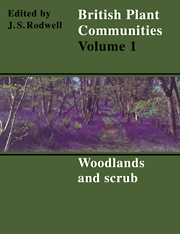Book contents
- Frontmatter
- Contents
- List of Figures
- Foreword
- Preface and Acknowledgements
- Preamble
- General Introduction
- Woodlands and Scrub
- Introduction to Woodlands and Scrub
- Key To Woodlands and Scrub
- Community Descriptions
- W1 Salix Cinerea-Galium Palustre woodland
- W2 Salix Cinerea-Betula Pubescens-Phragmites Australis Woodland
- W3 Salix Pentandra-Carex Rostrata Woodland
- W4 Betula Pubescens-Molinia Caerulea Woodland
- W5 Alnus Glutinosa-Carex Paniculata Woodland
- W6 Alnus Glutinosa-Urtica Jzozca Woodland
- W7 Ainus Glutinosa-Fraxinus Excelsior-Lysimachia Nemorum Woodland
- W8 Fraxinus Excelsior-Acer Campestre-Mercurialis Perennis Woodland
- W9 Fraxinus Excelsior-Sorbus Aucuparia-Mercurialis Perennis Woodland
- W10 Quereus Robur-Pteridium Aquilinum-Rubus Fruticosus Woodland
- W11 Quereus Petraea-Betula Pubescens-Oxalis Acetosella Woodland
- W12 Fagus Sylvatica-Mercurialis Perennis Woodland
- W13 Taxus Baccata Woodland
- W14 Fagus Sylvatica-Rubus Fruticosus Woodland
- W15 Fagus Sylvatica-Deschampsia Flexuosa Woodland
- W16 Quereus spp.-Betula spp.-Deschampsia Flexuosa Woodland
- W17 Quereus Petraea-Betula Pubescens-Dicranum Majus Woodland
- W18 Pinus Sylvestris-Hylocomium Splendens Woodland
- W19 Juniperus Communis Ssp. Communis-Oxalis Acetosella Woodland
- W20 Salix Lapponum-Luzula Sylvatica Scrub
- W21 Crataegus monogyna-Hedera helix scrub
- W22 Prunus Spinosa-Rubus Fruticosus Scrub
- W23 Ulex Europaeus-Rubus Fruticosus Scrub
- W24 Rubus Fruticosus-Holcus Lanatus Underscrub
- W25 Pteridium Aquilinum-Rubus Fruticosus Underscrub
- Index of Synonyms to Woodlands and Scrub
- Index of Species in Woodlands and Scrub
- Bibliography
W23 - Ulex Europaeus-Rubus Fruticosus Scrub
Published online by Cambridge University Press: 04 July 2020
- Frontmatter
- Contents
- List of Figures
- Foreword
- Preface and Acknowledgements
- Preamble
- General Introduction
- Woodlands and Scrub
- Introduction to Woodlands and Scrub
- Key To Woodlands and Scrub
- Community Descriptions
- W1 Salix Cinerea-Galium Palustre woodland
- W2 Salix Cinerea-Betula Pubescens-Phragmites Australis Woodland
- W3 Salix Pentandra-Carex Rostrata Woodland
- W4 Betula Pubescens-Molinia Caerulea Woodland
- W5 Alnus Glutinosa-Carex Paniculata Woodland
- W6 Alnus Glutinosa-Urtica Jzozca Woodland
- W7 Ainus Glutinosa-Fraxinus Excelsior-Lysimachia Nemorum Woodland
- W8 Fraxinus Excelsior-Acer Campestre-Mercurialis Perennis Woodland
- W9 Fraxinus Excelsior-Sorbus Aucuparia-Mercurialis Perennis Woodland
- W10 Quereus Robur-Pteridium Aquilinum-Rubus Fruticosus Woodland
- W11 Quereus Petraea-Betula Pubescens-Oxalis Acetosella Woodland
- W12 Fagus Sylvatica-Mercurialis Perennis Woodland
- W13 Taxus Baccata Woodland
- W14 Fagus Sylvatica-Rubus Fruticosus Woodland
- W15 Fagus Sylvatica-Deschampsia Flexuosa Woodland
- W16 Quereus spp.-Betula spp.-Deschampsia Flexuosa Woodland
- W17 Quereus Petraea-Betula Pubescens-Dicranum Majus Woodland
- W18 Pinus Sylvestris-Hylocomium Splendens Woodland
- W19 Juniperus Communis Ssp. Communis-Oxalis Acetosella Woodland
- W20 Salix Lapponum-Luzula Sylvatica Scrub
- W21 Crataegus monogyna-Hedera helix scrub
- W22 Prunus Spinosa-Rubus Fruticosus Scrub
- W23 Ulex Europaeus-Rubus Fruticosus Scrub
- W24 Rubus Fruticosus-Holcus Lanatus Underscrub
- W25 Pteridium Aquilinum-Rubus Fruticosus Underscrub
- Index of Synonyms to Woodlands and Scrub
- Index of Species in Woodlands and Scrub
- Bibliography
Summary
Synonymy
Scrub associations Tansley 1911 p.p.; Ulicetum Tansley 1939 p.p.; Ulex europaeus scrub Grubb et al. 1969 p.p.; Cliff Scrub Nodum Malloch 1970 p.p.; Pteridium aquilinum-Ulex europaeus Association (Birse & Robertson 1976) Birse 1984.
Constant species
Rubus fruticosus agg., Ulex europaeus, Agrostis capillaris.
Physiognomy
The Ulex europaeus-Rubus fruticosus agg. scrub has a fairly low woody cover, usually between 1 and 2 m high, in which U. europaeus is generally the dominant plant. Its physiognomy is very variable: where the scrub is browsed (the young gorse shoots providing a palatable bite), the bushes can be kept trimmed to rounded hummocks, sometimes with a central tuft of inaccessible branches; where the gorse grows free of browsing or has not been recently burned, the bushes grow tall and leggy, with their foliage out of reach of any herbivores that get access subsequently; where there is regeneration after burning from basal or buried stems, there can be a low sward of young shoots. Quite often, gorse is accompanied here by Cytisus scoparius, particularly on the more acid soils, and in some stands this can be the sole dominant.
U. europaeus figures widely as a component of various kinds of heath in Britain, where it can accompany U. gallii to the west and/or U. minor in the south, as well as Calluna vulgaris and Erica cinerea. Apart from Calluna, which makes a very occasional contribution, all these species are typically absent here. Usually, the only other members of the scrubby cover are Rubi: Rubus fruticosus agg. is very frequent, though its cover is generally low, and R. idaeus occurs occasionally.
In dense Ulex-Rubus scrub, there is next to no vegetation beneath the bushes, the ground being bare or covered with a layer of the cast spiny shoots, and herbaceous plants being limited to areas between the gorse; where the growth is more open and leggy, the herbage can be more or less continuous, especially where animals graze beneath the bushes. Strictly speaking, the associated plants can hardly be called a field layer: by and large, the vegetation presents the appearance of a grassland with gorse and broom, and the affinities of the herbaceous element are clearly with the more mesotrophic forms of Festuca-Agrostis-Galium grassland. Agrostis capillaris is usually very common and Festuca rubra frequent with Holcus lanatus and Dactylis glomerata represented a little more unevenly.
- Type
- Chapter
- Information
- British Plant Communities , pp. 352 - 356Publisher: Cambridge University PressPrint publication year: 1991

